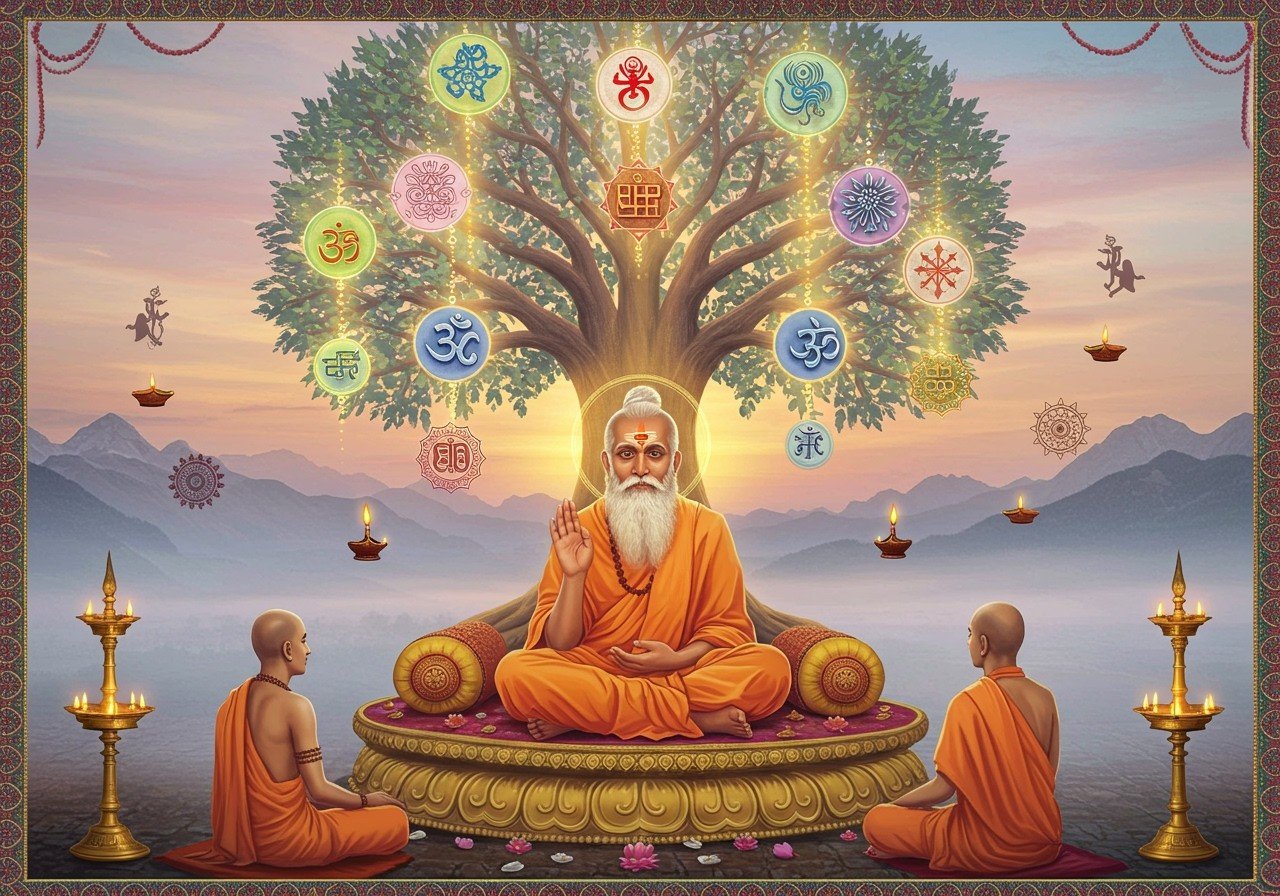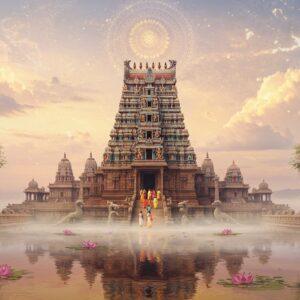
In the rich tapestry of Hindu traditions, sampradaya holds a vital place. It represents the lineage through which spiritual wisdom is passed down across generations. At the heart of each sampradaya stands the guru, a guide who ensures the teachings remain true and meaningful. Understanding the guru’s role in sampradaya is essential for those seeking spiritual growth and enlightenment within these traditions.
Understanding Sampradaya
Defining Sampradaya in Hinduism
Sampradaya is a spiritual lineage or tradition crucial for preserving religious teachings. It transmits knowledge, practices, and values across generations. The guru acts as the custodian of this spiritual wisdom.
Diverse Traditions
Hinduism encompasses various sampradayas, including Shaiva, Shakta, Vaishnava, and Smarta. Each has unique beliefs, rituals, and practices, enriching the spiritual landscape and offering multiple paths to understanding and enlightenment.
Parampara: Succession of Teachers
Parampara, the succession of teachers and disciples within a sampradaya, ensures that teachings remain authentic and adapt to modern contexts while honoring traditional values.
The Role of a Guru
Definition of a Guru
In Hinduism, a guru is a spiritual teacher guiding disciples toward enlightenment. “Guru” means “dispeller of darkness,” where darkness represents ignorance. The guru’s role is pivotal in guiding followers toward self-realization.
Spiritual Guidance
A guru provides personalized guidance to each disciple (shishya) based on their spiritual needs. This mentorship fosters spiritual growth and progress toward enlightenment. The guru tailors instructions to each disciple’s unique journey, ensuring advancement in their spiritual development. This individual attention ensures that teachings resonate with the disciple’s specific challenges and aspirations.
Knowledge and Experience
Gurus possess profound spiritual knowledge and experience, often having direct encounters with divine visions or grace. They share experiential wisdom, counsel, and inspire their disciples. Their insights mold values and foster spiritual discipline, helping disciples navigate the complexities of spiritual life.
Oral Tradition
Traditionally, knowledge was transmitted orally from guru to disciple, with disciples living near their gurus for direct learning. This method preserves the authenticity of the teachings, a practice still valued in today’s world. This close relationship allows for deep immersion in the teachings and a strong bond between guru and disciple.
Moksha and Self-Realization
A guru’s guidance is believed to lead disciples toward moksha, ultimate liberation. By following the guru’s teachings, students can realize their true Self (Atman). The guru helps remove the veils of ignorance, enabling disciples to perceive the divine within themselves. This realization is the culmination of the spiritual journey, leading to liberation from the cycle of birth and death.
Guru-Shishya Parampara
The lineage of teachers, or guru-shishya parampara, is crucial in Hindu traditions. This unbroken chain of spiritual guides safeguards the purity of teachings across generations. Disciples become part of this lineage through diksha, initiation from their guru. This initiation signifies a formal commitment to the spiritual path and the guru’s guidance.
Continuing the Tradition
Gurus play a vital role in preserving the Hindu way of life by passing down religious teachings and cultural practices to future generations. This continuity strengthens the community’s link to its spiritual heritage and ensures its survival in changing times. The guru’s efforts help maintain the vibrancy and relevance of Hindu traditions in the modern world.
Spiritual Authority
The guru is a respected spiritual authority, essential for understanding scriptures. Many believe that divine blessings flow through the genuine spiritual teacher, who speaks and acts on behalf of God. This authority is earned through years of study, practice, and spiritual realization, making the guru a revered figure in the community. The guru’s insights provide clarity and guidance on the complexities of spiritual texts.
While having a guru can be highly beneficial, it isn’t mandatory for all Hindus. Individuals can choose their spiritual path based on their beliefs and circumstances. However, those seeking a deeper connection to their spiritual roots often benefit from a guru’s wisdom. For more information on the Guru’s importance, you can refer to resources on Finding Your Guru: Guidance for Your Spiritual Journey and Exploring Hinduism: Core Beliefs and Practices.
How Poojn.in Supports Your Spiritual Journey with a Guru
Poojn.in offers essential items for guru-related rituals and worship within the Sampradaya tradition. This online platform provides authentic puja items to maintain the sacred guru-shishya connection. For items related to deities and worship, explore Ladoo Gopal statues and Radha Krishna Murtis available on Poojn.in.
For guru puja and related ceremonies, Poojn.in provides:
- Pure cotton asanas (seats) for guru worship: These asanas provide a respectful and comfortable seat for the guru during ceremonies. They symbolize reverence and create a conducive environment for spiritual practices.
- Traditional aarti thalis with all necessary components: Aarti thalis are essential for performing aarti, a ritual of offering light to the guru. They contain all the necessary items, including a diya (lamp), incense, and kumkum, simplifying the process for devotees.
- High-quality brass and copper kalash for ceremonial use: Kalash are sacred vessels used in various Hindu rituals, including guru puja. Poojn.in offers high-quality kalash made from traditional materials, ensuring authenticity and durability. These kalash add to the sanctity of the ceremonies.
- Pure cotton vastras (clothing) for guru puja: Offering new clothes to the guru is a common practice in guru puja. Poojn.in offers pure cotton vastras that are both comfortable and respectful, symbolizing purity and devotion. These vastras add to the dignity of the ceremony.
- Authentic dhoop and agarbatti for ritual purposes: Incense plays a significant role in creating a sacred atmosphere during puja. Poojn.in offers authentic dhoop and agarbatti made from traditional ingredients, enhancing the spiritual experience. The fragrant smoke purifies the environment and promotes a sense of peace and tranquility.
- Premium quality akshat (rice) and roli for tilak: Akshat and roli are used for applying tilak, a mark on the forehead that signifies blessings and good fortune. Poojn.in provides premium quality akshat and roli, ensuring the purity and sanctity of this ritual. The tilak symbolizes the guru’s blessings and spiritual connection.
- Traditional bells and shankhs for ceremonies: Bells and shankhs are used in Hindu ceremonies to invoke divine energy and create a sacred atmosphere. Poojn.in offers traditional bells and shankhs, adding to the authenticity and spiritual significance of the rituals. The sounds of these instruments purify the environment and enhance the spiritual vibrations.
Poojn.in provides detailed product descriptions explaining ritual significance and proper usage. All items meet traditional standards, with the convenience of doorstep delivery across India. Explore Poojn.in’s Kushal Mangal Sandalwood Agarbatti and Kushal Mangal Rose Agarbatti for your puja needs. Poojn.in maintains strict quality control, sourcing from verified traditional artisans and manufacturers. Customer support helps you select the right items for specific guru-related ceremonies.
Visit www.poojn.in to explore authentic puja items for guru worship and uphold the sacred guru-shishya tradition with appropriate ritual items.
Embracing the Path with a Guru
In life’s journey, the guru’s role in Sampradaya is like a guiding star, illuminating the path to spiritual growth and self-discovery. For those who value tradition and seek enlightenment, a guru offers wisdom, experience, and personal connection. By embracing a guru’s guidance, disciples join an ancient lineage nurturing spiritual practices, ensuring their vibrancy and relevance. For more insights into Hindu scriptures and traditions, refer to Hindu Scriptures: A Detailed Exploration and Sacred Texts of Hinduism: A Guide to Key Scriptures.
Even in modern times, a guru’s teachings resonate deeply, bridging ancient wisdom and contemporary life. Whether seeking moksha or deeper self-understanding, the guru becomes a trusted companion on this sacred journey. While not everyone chooses to follow a guru, those who do often experience a life enriched with purpose, clarity, and profound connection to their spiritual heritage. Honoring the guru-shishya parampara celebrates the timeless bond linking us to our past, guiding us toward an enlightened future.
FAQs: The Role of a Guru in Sampradaya
What is the meaning of Sampradaya? Sampradaya signifies a tradition or lineage within Hinduism, passing down teachings and practices through generations, ensuring the preservation of spiritual knowledge. It acts as a living repository of ancient wisdom, adapting to contemporary contexts while maintaining its core essence.
Why is a Guru important in Sampradaya? A Guru is crucial in Sampradaya for guiding disciples on the spiritual path, imparting wisdom, ensuring proper adherence to teachings, and fostering spiritual growth through personalized guidance and mentorship.
What is the role of a Sampradaya Acharya? A Sampradaya Acharya is a respected teacher or leader within a specific tradition, upholding the teachings, leading rituals, ensuring the lineage’s continuity, and acting as a custodian of the tradition’s knowledge and practices.
Who is an Adiguru in Sampradaya? An Adiguru is the original or first Guru in a specific Sampradaya, establishing the founding teachings and practices followed by subsequent Gurus and disciples, and laying the foundation for the entire lineage.
How does a Guru in Gaudiya Sampradaya guide disciples? In Gaudiya Sampradaya, a Guru guides disciples through devotional practices like chanting, scriptural study, personal example, emphasizing the worship of Lord Krishna, and fostering a deep personal relationship with the divine.
What is Guru Parampara in Sampradaya? Guru Parampara is the succession of Gurus within a Sampradaya, an unbroken chain of spiritual teachers ensuring accurate transmission of teachings across generations, preserving the authenticity and purity of the lineage.
Can anyone become a Guru in Sampradaya? Becoming a Guru isn’t open to everyone. It requires deep spiritual knowledge, realization, and often formal initiation or recognition within the Sampradaya, demonstrating both intellectual and experiential mastery of the tradition.
How does one choose a Guru in Sampradaya? Choosing a Guru involves seeking guidance from elders, observing the Guru’s teachings and conduct, ensuring alignment with one’s spiritual goals, and feeling a deep resonance with the Guru’s wisdom and personality.


